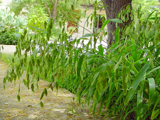Native Plants

Q. Who is Mr. Smarty Plants?
A: There are those who suspect Wildflower Center volunteers are the culpable and capable culprits. Yet, others think staff members play some, albeit small, role. You can torture us with your plant questions, but we will never reveal the Green Guru's secret identity.
Did you know you can access the Native Plant Information Network with your web-enabled smartphone?
Ask Mr. Smarty Plants is a free service provided by the staff and volunteers at the Lady Bird Johnson Wildflower Center.

rate this answer
Tuesday - December 09, 2014
From: Cushing, TX
Region: Southwest
Topic: Erosion Control, Ferns, Grasses or Grass-like, Herbs/Forbs, Shrubs
Title: Plants to prevent creekside erosion in Nacogdoches County, Texas
Answered by: Nan Hampton
QUESTION:
I am looking for some advice on plants native to Texas that can help prevent erosion. I own a wooded lot with a creek and would like to consolidate the sides of the creek against potential erosion. I'd like to find plants that could fill that purpose keeping in mind that it's a natural-looking environment in the middle of the woods (low light). Someone recommended "button bush" but I'm not sure that's the best choice. Thanks for your advice!ANSWER:
Cephalanthus occidentalis (Common buttonbush) would be an excellent choice for the creekside. It is frequently found along streams and does well in shade and part shade and is native to Nacogdoches County.
Here are some other plants that would fit your criteria that are also native to Nacogdoches County:
Shrubs:
Aesculus pavia (Scarlet buckeye) is another shrub that likes moist soil and grows in part shade.
Callicarpa americana (American beautyberry) thrives in moist soils and part shade. It is valuable as a wildlife food plant.
Euonymus americanus (American strawberry-bush) does well in part shade and moist soils.
Itea virginica (Virginia sweetspire) an understory shrub that grows well in part shade, moist soil and is noted for its erosion control capabilities.
Grasses: Grasses have extensive fibrous roots that hold the soil well.
Chasmanthium latifolium (Inland sea oats) is a beautiful grass that likes wet soils and thrives in the shade and part shade.
Andropogon glomeratus (Bushy bluestem) is an attractive grass that also loves moist soils, but it needs full sun to thrive.
Ferns: Ferns do well in shade and part shade in moist soils.
Athyrium filix-femina (Common ladyfern) is a large fern, growing to 2-3 feet high.
Pteridium aquilinum (Western bracken fern) is also a large fern and grows in dry soils as well as wet soils in shade and part shade.
Herbs:
Conoclinium coelestinum (Blue mistflower) grows in sun and part shade and attracts butterflies.
Salvia lyrata (Lyreleaf sage) is evergreen, grows in sun, part shade and shade and tolerates flooding.
Teucrium canadense (Canada germander) grows in moist soils in part shade and near streams.
From the Image Gallery
More Ferns Questions
Hanging plants for Austin, TX
May 18, 2014 - I'm looking for a hanging potted flower suggestion for Austin. Most locations are shaded under a large tree, but some locations may have several hours of afternoon sun. I'd love to see some hummin...
view the full question and answer
Are philodendrons, variegated ginger, sword ferns and palms toxic to horses?
February 24, 2009 - Are philodendrons, variegated ginger, sword ferns and palms toxic to horses?
view the full question and answer
Smarty Plants on thousand year old interrupted fern
April 03, 2005 - We recently built a new home in the mountains of western Virginia. I am told
by the local Botanist that there is a patch of "thousand year old interrupted
fern" that runs through, among other pla...
view the full question and answer
Plants to grow in shady sand in Florida
March 31, 2013 - We live in central Florida (directly between Orlando and Tampa). Our yard is mostly sand for soil and difficult parts in shade almost all day from large trees. What ground cover (grass) and hedges can...
view the full question and answer
transplanting Maidenhair Fern (Adiantum capillus-veneris)
October 25, 2011 - Behind our house is a huge grotto with a spring flowing through it that runs into a creek. Because of the constant flow of water, there are many of the Maidenhair Ferns (Adiantum capillus-veneris). I ...
view the full question and answer
| Support the Wildflower Center by Donating Online or Becoming a Member today. |

